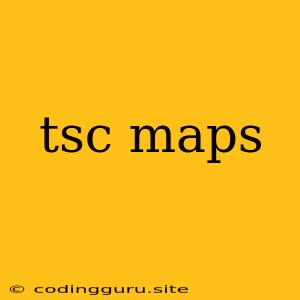Understanding the Power of tsc Maps: Unlocking Efficient TypeScript Development
Have you ever found yourself staring at a cryptic error message in your TypeScript project, completely lost in a sea of cryptic symbols and file paths? This is where TypeScript compiler (tsc) maps come to your rescue. They act as essential guides, bridging the gap between the complex world of compiled TypeScript and the human-readable source code you write.
But what exactly are tsc maps, and how do they work?
In essence, tsc maps are JSON files that store a precise correspondence between the compiled JavaScript code and the original TypeScript source. They act as a bridge, allowing you to effortlessly navigate from the error messages thrown by the compiled code back to the specific lines in your TypeScript source code.
Let's break down the key benefits of tsc maps:
- Pinpointing Errors: Instead of wrestling with obfuscated error messages,
tscmaps help you pinpoint the exact location of issues in your TypeScript code. This saves you countless hours debugging and frustration. - Enhanced Debugging: When using debugging tools like Chrome DevTools,
tscmaps enable you to seamlessly step through your TypeScript code, making it easier to understand the flow of your program and identify potential bugs. - Improved Code Comprehension: Even when not directly debugging,
tscmaps can be invaluable for understanding the relationship between the compiled JavaScript and your TypeScript source. This is especially helpful when working on large and complex projects.
How to Generate and Utilize tsc Maps
Generating tsc maps is incredibly simple. You can enable them using the --sourceMap flag during compilation. For instance, the command tsc --sourceMap myFile.ts will compile myFile.ts and generate a corresponding .map file, such as myFile.js.map.
Let's illustrate this with a quick example:
// myFile.ts
function greet(name: string): string {
return "Hello, " + name + "!";
}
console.log(greet("World"));
Compiling this with tsc --sourceMap myFile.ts will generate myFile.js and myFile.js.map.
To utilize tsc maps effectively:
- Ensure
tscmaps are enabled in your TypeScript configuration file (tsconfig.json). This makes map generation automatic. - Configure your browser's developer tools to use source maps. This allows you to see your original TypeScript code during debugging.
- Leverage debugging tools like Chrome DevTools, Visual Studio Code, or any other IDE that supports source maps. These tools will automatically load and interpret
tscmaps.
Key Points to Consider:
tscmaps are not meant to be directly edited. Modifying them can introduce inconsistencies between the compiled code and the source.tscmaps are not a substitute for writing clean and well-structured code. They are a tool to assist you in debugging and understanding your TypeScript code.
In Summary:
tsc maps are an indispensable tool for any TypeScript developer. They streamline the debugging process, enhance code comprehension, and ultimately boost your productivity. By leveraging tsc maps, you can navigate the intricacies of compiled TypeScript with confidence, ensuring your projects are bug-free and efficient.
